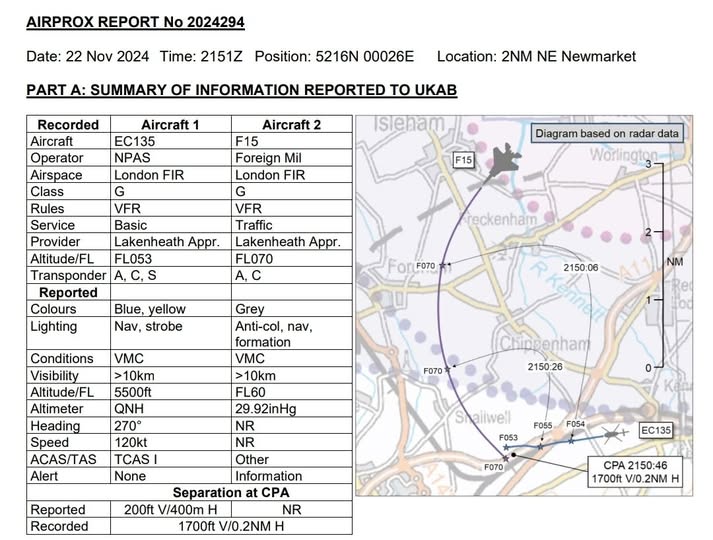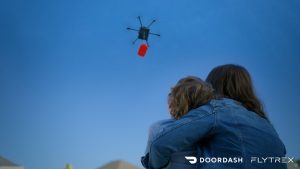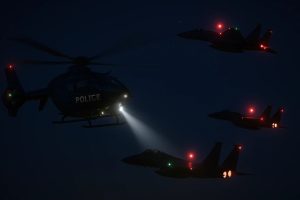USAF F-15 and Police Helicopter Near Miss Over Newmarket: The Untold Story of Airspace, Accountability, and “Drone Hysteria”
Envision a tranquil Friday over Cambridgeshire. The countryside appears serene, yet the skies are bustling, particularly near Newmarket where standard security patrols are the focus of the day. Yet, as the old adage goes, “it’s Friday, nobody is looking,” and what subsequently unfolds reveals a dramatic narrative of airspace confusion, regulatory errors, and an incident echoing within aviation, drone, and public safety sectors.
This article delves deeply into a near-collision between a USAF F-15 jet and a police helicopter, exploring the causes, implications for drone operators and airspace administrators, and the lengthy journey required to uncover the truth.
1. The Incident: What Really Happened Above Newmarket?
On an otherwise typical Friday, a UK National Police Air Service (NPAS) helicopter and a United States Air Force F-15 based at RAF Lakenheath narrowly escaped a collision over Newmarket, Cambridgeshire. The F-15 pilot, in communication with air traffic control (ATC), observed the police helicopter at about one nautical mile’s distance and 1,000 feet below. Using sophisticated sensors to monitor the helicopter, the fighter pilot unsuccessfully attempted thrice to establish direct radio contact, resulting only in a brief acknowledgment: “We are going to RTB” (“Return to Base”).
In response, the police helicopter executed a swift 90-120° turn southward and descended rapidly, clearly perturbed, while the F-15 remained overhead and behind. Although physical contact was avoided, the incident was perilously close to disaster for all parties involved.
2. How the Official Story Unraveled: From “Drone Near Miss” to Fighter Jet
Initially, the occurrence was recorded and disseminated as another “drone near miss.” For months, authorities maintained a drone’s involvement was a given. The Airprox incident, part of the UK’s near-miss reporting system, led to strict new no-fly and restricted drone zones across the UK at the USAF’s request, though without compelling evidence to substantiate the actions.
A team of determined investigators and journalists, including Ian Hudson and Mike Morgan, spearheaded efforts to uncover the truth. Persistent Freedom of Information Act (FOIA) requests finally compelled authorities to reveal that the mysterious “drone” was indeed a USAF F-15.
This was more than a simple recording error; it highlighted classic mischaracterization and confirmation bias. Experienced aircrews, especially during night operations with Electro-Optical/Infrared technology, demonstrated that misidentification is possible if personnel anticipate seeing a drone.
3. Why Did It Take So Long to Get the Facts?
The slow progress of the investigation can be attributed to the disjointed nature of UK aviation reporting and oversight systems:
- FOIA Stonewalling: Authorities often countered their own narratives, withheld crucial information, and misguided both journalists and the public. The police helicopter’s video, capable of shedding light on the incident, was withheld—allegedly due to security or legal concerns.
- Inconsistent Reporting: It’s not uncommon for the UK Airprox Board to log incidents as “drone-related” before confirming involvement of manned aircraft.
- Media Echo Chamber: Initially, news outlets accepted the official narrative without question, inadvertently stoking public fears about drones.
It was through relentless journalistic efforts that the true story emerged, highlighting significant weaknesses in aviation incident investigation and documentation.
4. Drone Regulations: Consequences and Overreactions
The aftermath of this incident serves as a cautionary tale for drone hobbyists and enterprises:
- Drone No-Fly Zones: At the urging of the USAF, the UK Civil Aviation Authority (CAA) enforced sweeping new drone-constraining zones throughout the UK—policies that remain despite having no direct relevance to this near-miss.
- Economic Impact: These restrictions have incurred multimillion-pound losses for the UK’s drone industry, excessively burdening small business operators who comply with the law but now face additional constraints, lost income, and eroded client trust.
- Reputational Damage: The drone sector continues struggling with repercussions from misreported or misunderstood incidents, where a single event can trigger widespread regulatory responses.
- Policy Gaps: The situation has exposed deficiencies in police protocols for pursuing or intercepting suspected drones with helicopters—a tactic considered inherently risky and potentially deadly according to experts.
5. Lessons in Airspace Safety: Human Error, Technology, and Communication
This near-miss incident underscores that it wasn’t merely a technological breakdown—it was a sequence of human mistakes and communication failures:
- Situational Awareness Gaps: Despite the F-15 pilot maintaining visual and sensor links to the helicopter, the police crew was unaware of the fighter jet’s proximity until too late.
- ATC Limitations: While Air Traffic Control supplied data to the F-15, the helicopter was left uninformed of the impending risk.
- Radio Chaos: The F-15’s attempts to contact the police helicopter went unanswered.
- Confirmation Bias: Aircrews tasked with drone spotting risk “seeing what they anticipate,” leading to misidentifications.
“This incident highlights that aircrews, particularly at night with Electro-Optical/Infrared gear, can misidentify manned aircraft as drones…it shows that even seasoned crews are susceptible to confirmation bias.”
6. Who Pays the Price? Impact on Drone Industry and Small Businesses
The decision to assign new restrictions to drone flight paths—unfoundedly—has deeply affected the UK’s drone sector:
- Small Business Losses: Numerous operators comply with legal requirements yet now face canceled contracts and growing administrative burdens.
- Industry Frustration: The UK’s primary drone organization, ARPAS, faced scrutiny for inadequate representation or opposition.
- Public Confusion: Misreported drone incidents perpetuate public distrust in innovative and responsible drone usage.
7. Behind the Scenes: Investigators, Journalists, and the Fight for Truth
Thanks to the tenacious efforts of independent journalists and FOIA campaigners, such as Ian Hudson and Mike Morgan, the truth surfaced, compelling authorities to confess the true nature of the incident.
This narrative also challenges the press to question official claims, especially amid “drone hysteria,” which ordinarily requires evidence-based skepticism.
8. Expert Insights and Safety Recommendations
For Aircrews and ATC:
- Ensure relayed situational awareness: Employ real-time updates for both manned and unmanned users.
- Enhance radio protocols: Conduct tests and verify contact, particularly in densely populated or diverse airspaces.
- Recognize confirmation bias effects: Train aircrews to explore alternative explanations for unexpected observations, especially under poor visibility conditions or at night.
For Drone Operators and Businesses:
- Remain vigilant of new airspace rules; restrictions shift swiftly.
- Maintain compliance documentation: Record logs and communications for proof of ethical conduct.
- Promote and educate: Dispel misinformation about drones among clients and the public to counter sensationalized narratives.
9. FAQs for Drone Users and Aviation Enthusiasts
Q: Will similar drone airspace restrictions be lifted now that the incident was misattributed?
A: As of June 2025, restrictions persist, though industry and advocacy groups are lobbying for a revision and reforms.
Q: What should I do if I witness or become involved in an airspace incident?
A: Accurately report all details and request the review and preservation of video, radio, and sensor data. Attempt independent evaluation, if feasible.
Q: Are manned aircraft frequently misidentified as drones?
A: Indeed, there are specific cases where commercial or police pilots mistake minor manned aircraft or even natural elements for drones, especially under stressed conditions or poor visibility.
10. Final Thoughts: How Do We Balance Safety, Progress, and Accountability?
This close call over Newmarket spotlights a broader issue: balancing sky safety with technological progress as drones, helicopters, and jets vie for airspace. The prudent path isn’t reflexive restriction nor reduced oversight, but rather data-supported policies, transparency, and ongoing cooperation among all involved parties.
Adding to this, a bit of vigilance and proactive oversight every Friday wouldn’t be remiss.













